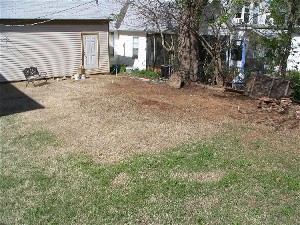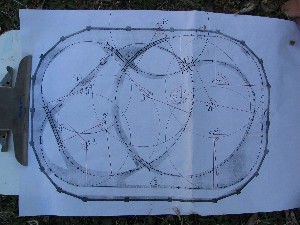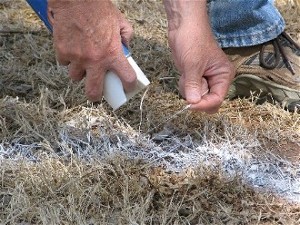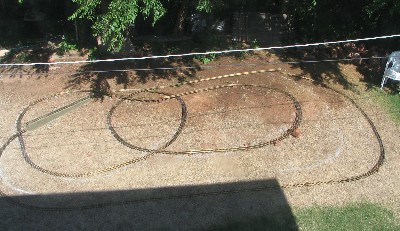|
Development of the
Sandflea and Redbud Garden Railway
Planning
 The first thing I did was stake the area and put up string to identify
the approximate location of the garden and surrounding walkways.
I then sprayed the area with herbicide to kill all
weeds and lawn (Bermuda grass) on the site. The herbicide treatment
had to be repeated several times over the next few months to kill all
Bermuda grass as well as new weeds.
The first thing I did was stake the area and put up string to identify
the approximate location of the garden and surrounding walkways.
I then sprayed the area with herbicide to kill all
weeds and lawn (Bermuda grass) on the site. The herbicide treatment
had to be repeated several times over the next few months to kill all
Bermuda grass as well as new weeds.
 I made numerous copies of the proposed track plan from an article in
Garden Railways ("The Broadview Loop & Short Creek
Railroad" by Helmut Zehnpfennig; April 1999, pp. 84-86). I drew
complete circles for all curves so that a center
point could be determined. This would aid in transferring the plan to the
ground. Although I didn't do it, templates are available that allow you to draw
the track plan piece-by-piece. Even then, tiny errors can accumulate over the
length of the track plan, resulting in some gap at the end.
I made numerous copies of the proposed track plan from an article in
Garden Railways ("The Broadview Loop & Short Creek
Railroad" by Helmut Zehnpfennig; April 1999, pp. 84-86). I drew
complete circles for all curves so that a center
point could be determined. This would aid in transferring the plan to the
ground. Although I didn't do it, templates are available that allow you to draw
the track plan piece-by-piece. Even then, tiny errors can accumulate over the
length of the track plan, resulting in some gap at the end.
 I began construction on April 15, 2004. I started by driving in a short
piece of rebar approximately at each curve center point. With a string of the appropriate
length (8 feet or 12 feet) tied around the rebar, I spray painted each
curve on the ground. I used a board to approximate the straight track and
painted the straight-aways on the ground, thereby connecting the
arcs.
I began construction on April 15, 2004. I started by driving in a short
piece of rebar approximately at each curve center point. With a string of the appropriate
length (8 feet or 12 feet) tied around the rebar, I spray painted each
curve on the ground. I used a board to approximate the straight track and
painted the straight-aways on the ground, thereby connecting the
arcs.
From one of the track plans, I estimated the length of 8-foot arcs,
12-foot arcs (these are standard diameters), and straight track. Each
straight section of track had to be made up of segments 1, 2, or 4 feet
in length. I then purchased the track according to these estimates. Of
course, I did not expect that the track plan's arcs and straight sections
would correspond exactly to the lengths of standard curved and straight
track. However, short segments can be purchased or track can be cut to
length to close the final gap if itís close. Again, using a template to
draw the track on paper would more accurately estimate the actual pieces of
track (lengths and arcs) needed.

After purchasing the track, I laid out the pieces on the ground,
approximately over the painted lines. A short gap of about
3 inches occurred on one straight section. But, overall, the track I
purchased laid out very well, except that the track did not abut tightly
in all arcs. Since the garden appeared to be too track-intensive, I
decided to expand it some. So I expanded it exactly 1 foot on each end and
four feet on the front and back. This gave more space for plants and
features and also more length to reduce grades.
Tunnels will also reduce the amount of visible track.
I then made a sequential list of the track pieces on a computer spreadsheet so
that the track could be taken up. I put the exact length of each piece of
track on the list. I then computed the track length (added up the piece
lengths) in the three sections between track-crossovers. This gave me
lengths of 297 inches, 411 inches, and 554 inches. I estimated a desired
track crossover height of +9 inches for the first two lengths, and -18 inches
for the third length (which must cross over two tracks). I then
divided the respective crossover heights by the section lengths to obtain
three grades. I got grades of 3.03 percent, 2.19 percent, and 3.25 percent. These are
steep grades but I think they are acceptable. The last, steepest grade is mostly
straight track, which is easier to climb.
Back to the top of the page
Return to Garden Railway site index
|

